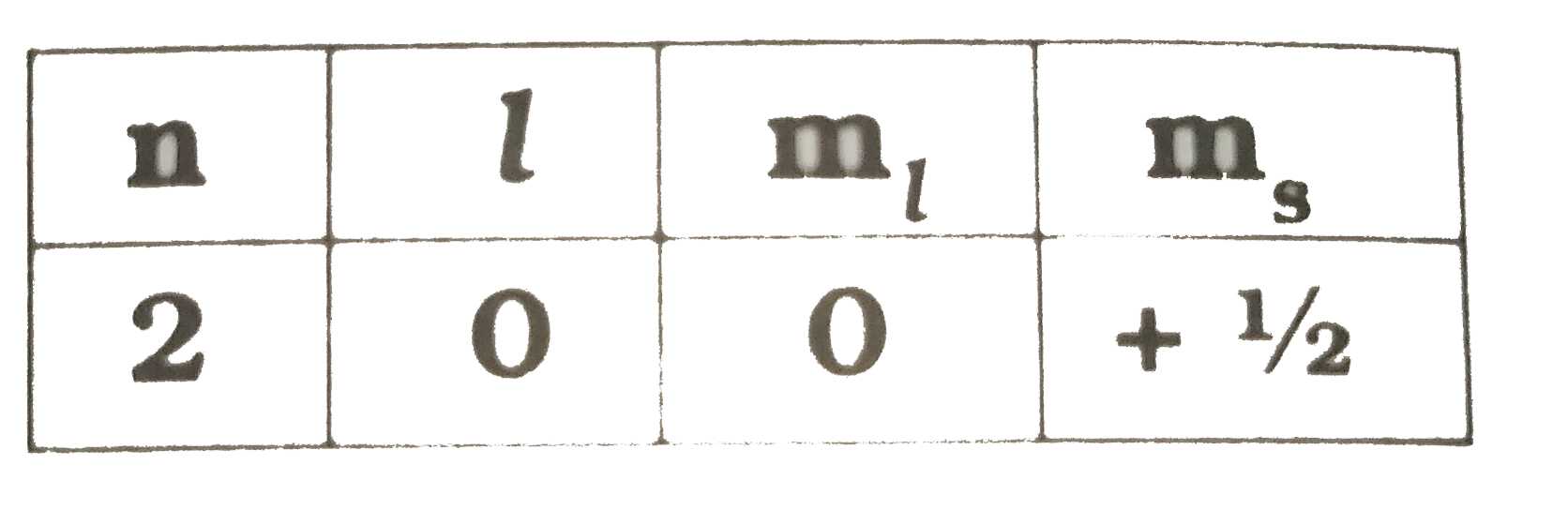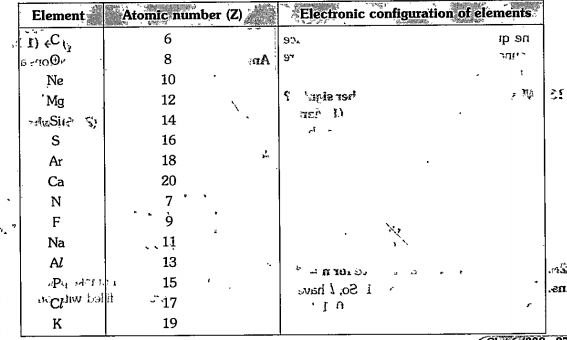Complete Solutions to EXAMPLE of chapter STRUCTURE OF ATOM of Class 10 book with complete answers and questions
| Class 10 | CHEMISTRY |
| Chapter | STRUCTURE OF ATOM |
| BEYOND PUBLICATION | EXAMPLE |
| Number Of Questions | 100 |
| Academic Year | 2023-24 |
What information does the electronic configuration of an atom provide ?
01:25View SolutionWhat is electronic configuration?
05:04View SolutionRainbow is an example for continuous spectrum - Explain
01:40View SolutionHow rainbow is a continuous spectrum ?
01:22View SolutionWhich is naturally occurring continuous spectrum ?Explain.
01:44View SolutionWhat is absorption spectrum?
01:43View SolutionWhat is absorption spectrum?
01:43View SolutionWhat is spectrum? How many types of spectrum are there?
04:34View SolutionWhat is an orbital? How is it different from Bohr's orbit ?
02:37View SolutionWhat is the difference between an orbit and orbital ?
01:30View SolutionExplain the significance of three quantum numbers in predicting the positions of an electron in an orbit .
04:14View SolutionHow do you appreciate Niels Bohr for his contributions to under standing atomic structure?
02:43View SolutionWhat is `n l^(x)` method ? How is it useful ?
01:58View SolutionWhat is emission spectrum?
01:16View SolutionWhat is emission spectrum?
01:16View SolutionWhen radiation is emitted then what is the name given to such spectrum. Explain such spectrum ?
02:12View SolutionWhich electron shell is at a higher energy level K or L ?
01:06View SolutionExplain the reason for K-shell has lower energy than the L - shell.
01:28View SolutionHow many maximum number pf electrons can be accommodated in a principal energy shell?
01:18View SolutionHow many maximum number of electrons that can be accommodated in a 'p' sub shell ?
01:17View SolutionHow many maximum number of electrons can be accommodated in an orbitals ?
00:52View SolutionHow many sub-shells are present in a principal energy shell ?
01:39View SolutionHow many spin orientation are possible for an electron in an orbital ?
01:19View SolutionIn an atom the number electrons in M-shell is equal to the number of electrons in the K and L shell. Answer the following questions. (AS1)
Which is the outer most shell?01:16View SolutionIn an atom the number electrons in M-shell is equal to the number of electrons in the K and L Shell. Answer the following questions.
How many electrons are there in its outermost shell?01:56View SolutionIn an atom the number electrons in M-shell is equal to the number of electrons in the K and L Shell. Answer the following questions.
What is the atomic number of element?01:51View SolutionIn an atom the number electrons in M-shell is equal to the number of electrons in the K and L Shell. Answer the following questions.
Write the electronic configuration of the element.02:01View SolutionHow many elliptical orbits are added by Sommerfeld in third Bohr's orbit? What was the purpose of adding these elliptical orbits ?
01:46View SolutionFollowing orbital diagram shows the electronic configuration of nitrogen atom. Which rule does not support this ?
 01:59View Solution
01:59View SolutionWhich rule is violated in the electronic configuration `1s^(0) 2 s^(2) 2p^(4)` ?
01:16View SolutionWrite the correct electronic configuration of the given nitrogen atom with the help of Hund's rule.
01:13View SolutionWhich rule is violated in the electronic configuration `1s^(0) 2s^(2) 2p^(4)` ?
01:36View SolutionWrite the corect electronic configuration of the given `1s^0 2s^2 2p^4` according to Aufbau principal.
01:35View SolutionWrite the four quantum numbers for the differentiating electron of sodium (Na) atom.
01:14View SolutionAn electron in an atom has the following set of four quantum numbers to which orbital it belong to :
 01:21View Solution
01:21View SolutionWrite four quantum numbers for `1s^(1)` electron.
00:58View SolutionCollect the information regarding wavelengths and corresponding frequencies of three primary colours red, blue and green.
01:00View SolutionCollect the information regarding wavelengths and corresponding frequencies of three primary colours red, blue and green.
01:00View SolutionThe wave length of a radio wave is 1.0m. Find its frequency.
01:43View SolutionCollect the information of historical development of the atomic theory.
03:28View SolutionCollect the information about the scientists who developed the atomic theories.
06:56View SolutionDraw the shapes of s, p and d orbitals.
01:00View SolutionHow do the sub-atomic particles coexist in an electrically neutral atom?
03:13View SolutionDo all atoms have the same sub-atomic particles?
01:01View SolutionWhy is an atom of one element different from the atoms of other elements?
02:30View SolutionHow are electrons distributed in the space of an atom?
05:27View SolutionHow many colours are there in a rainbow ? What are they ?
01:02View SolutionHow do the vibrating electric and magnetic fields around the charge become a wave that travels through space?
06:24View SolutionWhat are the characteristics of electromagnetic waves '?
00:53View SolutionCan we apply this equation `c = upsilon lambda` , to a sound wave '?
01:10View SolutionAre there any other wavelengths of light other than visible spectrum?
03:52View SolutionWhat happens when you heat an iron rod on a flame? Do you find any change in colour on heating an iron rod?
02:12View SolutionDo you observe any other colour at the same time when one colour ls emitted ?
01:22View SolutionDo you enjoy Deepavali fire works ? Variety of colours is seen from fire works. How do these colours come from fire works ?
02:35View SolutionDo you observe yellow light in street lamps? Which will produce yellow light?
01:00View SolutionWhy do different elements emit different flame colours when heated by the same non - luminous flame ?
01:19View SolutionWhat does a line spectrum tell us about the structure of an atom?
06:37View SolutionWhat happens when an electron gains energy ?
01:00View SolutionDoes the electron retain the energy forever ?
01:05View SolutionDid Bohr's model account for the splitting of line spectra of a hydrogen atom into finer lines ?
01:12View SolutionWhy is the electron in an atom restricted to revolve around the nucleus at certain fixed distances ?
01:00View SolutionDo the electrons follow defined paths around the nucleus
01:05View SolutionWhat is the velocity of the electron ?
01:09View SolutionIs it possible to find exact position of electron ? How do you find the position and velocity of an electron ?
01:17View SolutionDo atoms have a definite boundary, as suggested by Bohr's model'?
01:23View SolutionWhat do we call the region of space where the electron might be, at a given time ?
01:18View SolutionWhat information do the quantum numbers provide ?
01:07View SolutionWhat does each quantum number signify ?
02:07View SolutionWhat is the maximum value of l for n = 4 ?
01:09View SolutionHow many values can l have for n = 4 ?
00:58View SolutionDo all the p-orbitals have the same energy ?
01:05View SolutionHow do electrons in an atom occupy shells, sub-shells and orbitals?
09:01View SolutionHow are two electrons in the Helium atom arranged ?
01:09View SolutionWhat are the spins of two electrons in an orbital ?
01:22View SolutionHow many electrons are occupied by an orbital ?
01:12View SolutionFor carbon (C) atom (Z=6), where does the 6th electron go?
01:44View SolutionFor carbon (C) atom (Z=6), where does the 6th electron go? Whether the electron pairs up in the same p-orbital or will it go to the next p-orbital?
03:50View SolutionExplain the wave nature of light.
02:13View SolutionWrite an activity which shows metal produces colour in flame.
01:49View SolutionComplete the electronic configuration of the following elements.
 03:53View Solution
03:53View SolutionWhat is dispersion ?
01:10View SolutionWhat is electromagnetic specturm ?
01:30View SolutionWhat is Zeeman effect ?
01:50View SolutionWhat is spectrum? How many types of spectrum are there?
04:34View SolutionWhat is speed of electromagnetic wave ?
01:02View SolutionWhich colour of light has longest wavelength ?
00:45View SolutionThe electrons belong to which orbit neither loses nor gains energy ?
02:30View SolutionIf n = 5, then what is the maximum value for 'l'?
01:07View SolutionWhat is the probability of finding electron is called ?
00:59View SolutionIf l=4, what are the number of values for `m_l` ?
00:59View SolutionWhat are values of `m_(s)` ?
01:09View SolutionWhat is an electronic configuration ?
01:18View SolutionExplain Pauli's Exclusion principle with an example.
01:42View SolutionWhat is Aufbau principle ?
01:26View SolutionWhat is Hund's rule ?
01:26View SolutionWrite Planck's equation .
01:07View SolutionWhat is electromagnetic specturm ?
01:30View SolutionWhat is wavelength ?
01:11View SolutionWhat is frequency ?
01:03View SolutionExplain the formation of a rainbow.
05:59View Solution
EXAMPLE questions and complete solutions for chapter STRUCTURE OF ATOM of BEYOND PUBLICATION of Class 10
